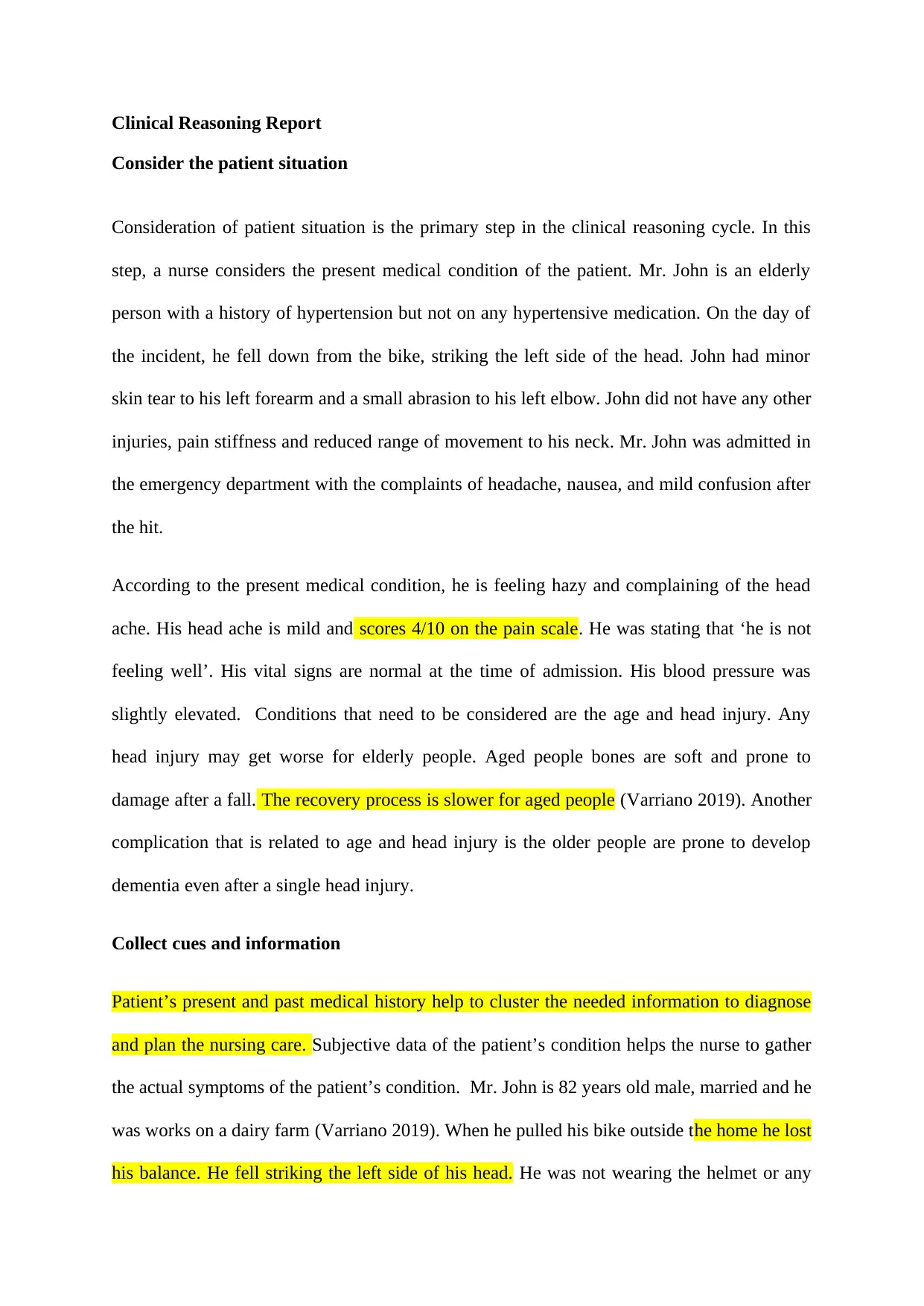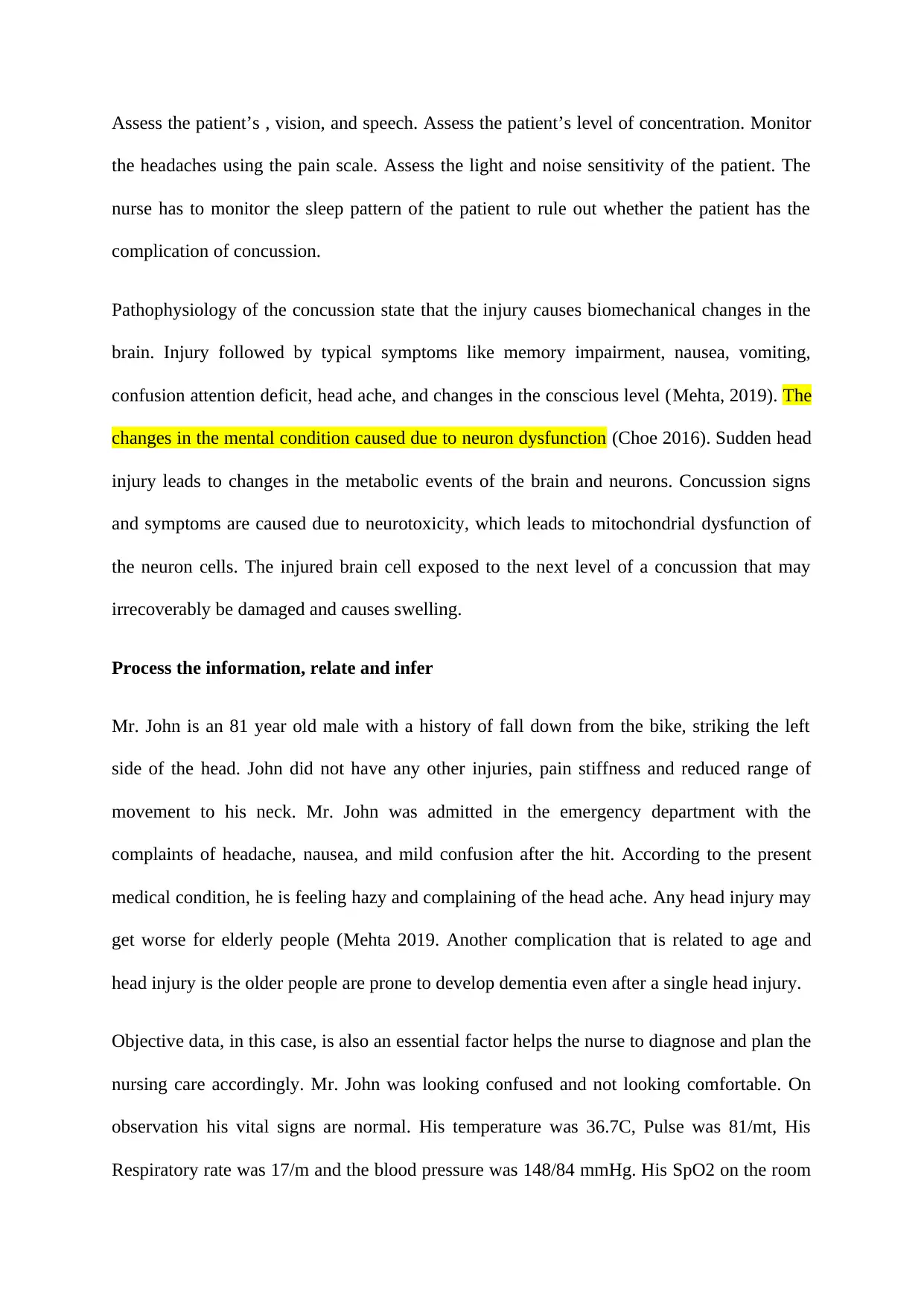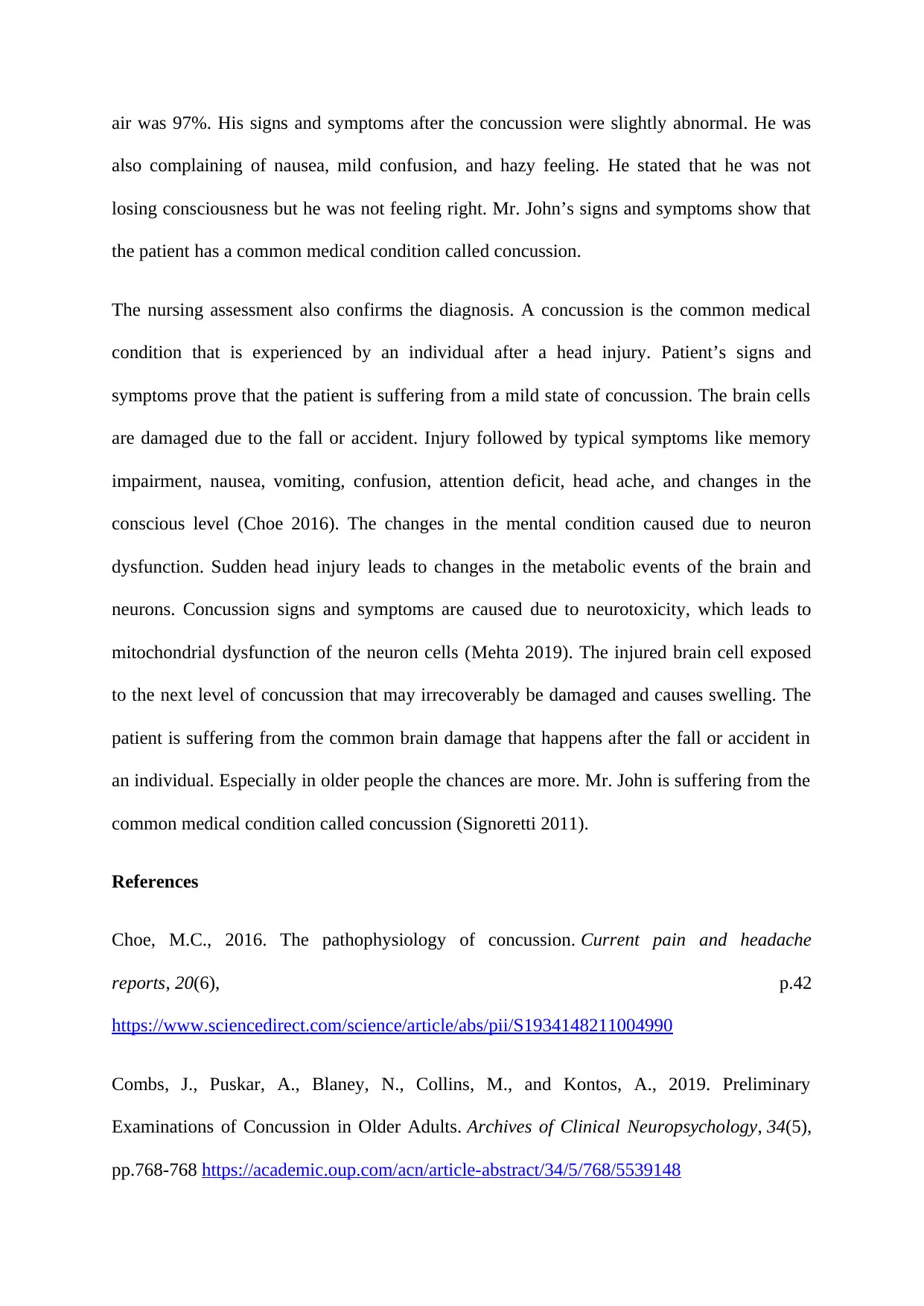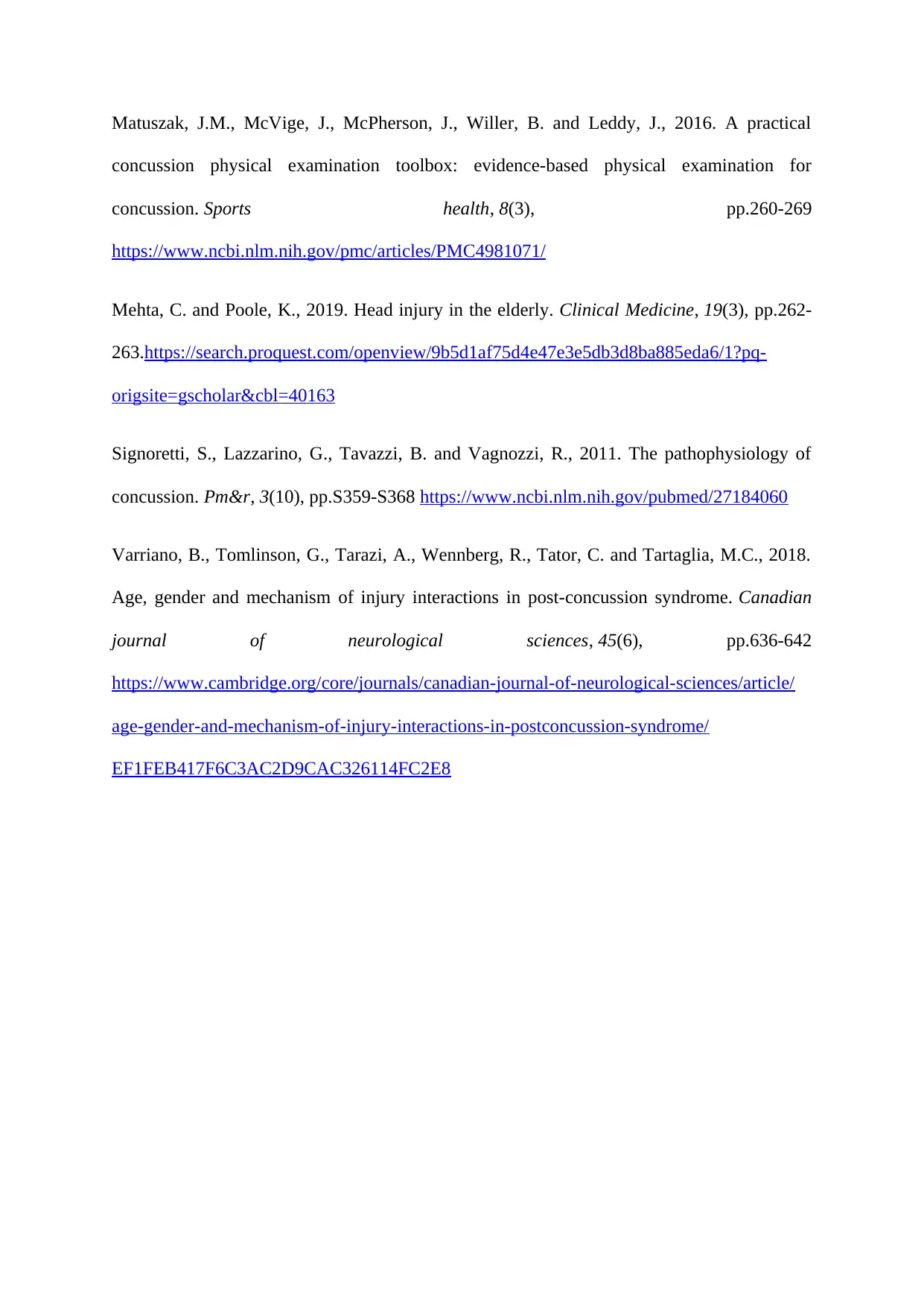Clinical Reasoning Report
VerifiedAdded on 2022/11/25
|5
|1638
|382
AI Summary
This Clinical Reasoning Report discusses the process of diagnosing and planning nursing care for a patient with a head injury. It explores the patient's symptoms, assessment, and the pathophysiology of concussion. The report also highlights the potential complications related to age and head injury in elderly patients.
Contribute Materials
Your contribution can guide someone’s learning journey. Share your
documents today.

Clinical Reasoning Report
Consider the patient situation
Consideration of patient situation is the primary step in the clinical reasoning cycle. In this
step, a nurse considers the present medical condition of the patient. Mr. John is an elderly
person with a history of hypertension but not on any hypertensive medication. On the day of
the incident, he fell down from the bike, striking the left side of the head. John had minor
skin tear to his left forearm and a small abrasion to his left elbow. John did not have any other
injuries, pain stiffness and reduced range of movement to his neck. Mr. John was admitted in
the emergency department with the complaints of headache, nausea, and mild confusion after
the hit.
According to the present medical condition, he is feeling hazy and complaining of the head
ache. His head ache is mild and scores 4/10 on the pain scale. He was stating that ‘he is not
feeling well’. His vital signs are normal at the time of admission. His blood pressure was
slightly elevated. Conditions that need to be considered are the age and head injury. Any
head injury may get worse for elderly people. Aged people bones are soft and prone to
damage after a fall. The recovery process is slower for aged people (Varriano 2019). Another
complication that is related to age and head injury is the older people are prone to develop
dementia even after a single head injury.
Collect cues and information
Patient’s present and past medical history help to cluster the needed information to diagnose
and plan the nursing care. Subjective data of the patient’s condition helps the nurse to gather
the actual symptoms of the patient’s condition. Mr. John is 82 years old male, married and he
was works on a dairy farm (Varriano 2019). When he pulled his bike outside the home he lost
his balance. He fell striking the left side of his head. He was not wearing the helmet or any
Consider the patient situation
Consideration of patient situation is the primary step in the clinical reasoning cycle. In this
step, a nurse considers the present medical condition of the patient. Mr. John is an elderly
person with a history of hypertension but not on any hypertensive medication. On the day of
the incident, he fell down from the bike, striking the left side of the head. John had minor
skin tear to his left forearm and a small abrasion to his left elbow. John did not have any other
injuries, pain stiffness and reduced range of movement to his neck. Mr. John was admitted in
the emergency department with the complaints of headache, nausea, and mild confusion after
the hit.
According to the present medical condition, he is feeling hazy and complaining of the head
ache. His head ache is mild and scores 4/10 on the pain scale. He was stating that ‘he is not
feeling well’. His vital signs are normal at the time of admission. His blood pressure was
slightly elevated. Conditions that need to be considered are the age and head injury. Any
head injury may get worse for elderly people. Aged people bones are soft and prone to
damage after a fall. The recovery process is slower for aged people (Varriano 2019). Another
complication that is related to age and head injury is the older people are prone to develop
dementia even after a single head injury.
Collect cues and information
Patient’s present and past medical history help to cluster the needed information to diagnose
and plan the nursing care. Subjective data of the patient’s condition helps the nurse to gather
the actual symptoms of the patient’s condition. Mr. John is 82 years old male, married and he
was works on a dairy farm (Varriano 2019). When he pulled his bike outside the home he lost
his balance. He fell striking the left side of his head. He was not wearing the helmet or any
Secure Best Marks with AI Grader
Need help grading? Try our AI Grader for instant feedback on your assignments.

other protective equipment. John had minor skin tear to his left forearm and a small abrasion
to his left elbow. John did not have any other injuries, pain stiffness and reduced range of
movement to his neck.
Objective data, in this case, is also an essential factor that helps the nurse to diagnose and
plan the nursing care accordingly. Mr. John was looking confused and not looking
comfortable. On observation, his vital signs are normal. His temperature was 36.7C, Pulse
was 81/mt, His Respiratory rate was 17/mt and the blood pressure was 148/84 mmHg. His
SpO2 on the room air was 97%. His signs and symptoms after the concussion were slightly
abnormal. He was complaining of head ache which scored 4/10 on the pain scale. He was
also complaining of nausea, mild confusion, and hazy feeling. He stated that he was not
losing consciousness but he was not feeling well. All the subjective complaints of the patient
were abnormal.
Changes that were identified are the signs and symptoms of concussion. A concussion is
common in older people after a head injury (Mehta 2019). Mr. John’s signs and symptoms in
the emergency department shows that he is having a medical condition called concussion
(Matuszak 2016). Mr. John states that he is feeling nauseated has head ache, mild confusion,
and hazy feeling which are the common signs and symptoms of concussion. The potential
problem is a concussion. The Nurse has to do an assessment and collect more data to
conclude the diagnosis of the patient.
The proposed new assessment is head to toe assessment. The nurse has to do optical
examination, mental status assessment, and the nurse has to check the range of motion,and
musculoskeletal assessment (Matuszak 2016). The nurse has to monitor the patient
continuously. Monitor the vital signs every half an hour. The mental status examination has
to be done every two hours to rule out any changes in the conscious level (Combs 2019).
to his left elbow. John did not have any other injuries, pain stiffness and reduced range of
movement to his neck.
Objective data, in this case, is also an essential factor that helps the nurse to diagnose and
plan the nursing care accordingly. Mr. John was looking confused and not looking
comfortable. On observation, his vital signs are normal. His temperature was 36.7C, Pulse
was 81/mt, His Respiratory rate was 17/mt and the blood pressure was 148/84 mmHg. His
SpO2 on the room air was 97%. His signs and symptoms after the concussion were slightly
abnormal. He was complaining of head ache which scored 4/10 on the pain scale. He was
also complaining of nausea, mild confusion, and hazy feeling. He stated that he was not
losing consciousness but he was not feeling well. All the subjective complaints of the patient
were abnormal.
Changes that were identified are the signs and symptoms of concussion. A concussion is
common in older people after a head injury (Mehta 2019). Mr. John’s signs and symptoms in
the emergency department shows that he is having a medical condition called concussion
(Matuszak 2016). Mr. John states that he is feeling nauseated has head ache, mild confusion,
and hazy feeling which are the common signs and symptoms of concussion. The potential
problem is a concussion. The Nurse has to do an assessment and collect more data to
conclude the diagnosis of the patient.
The proposed new assessment is head to toe assessment. The nurse has to do optical
examination, mental status assessment, and the nurse has to check the range of motion,and
musculoskeletal assessment (Matuszak 2016). The nurse has to monitor the patient
continuously. Monitor the vital signs every half an hour. The mental status examination has
to be done every two hours to rule out any changes in the conscious level (Combs 2019).

Assess the patient’s , vision, and speech. Assess the patient’s level of concentration. Monitor
the headaches using the pain scale. Assess the light and noise sensitivity of the patient. The
nurse has to monitor the sleep pattern of the patient to rule out whether the patient has the
complication of concussion.
Pathophysiology of the concussion state that the injury causes biomechanical changes in the
brain. Injury followed by typical symptoms like memory impairment, nausea, vomiting,
confusion attention deficit, head ache, and changes in the conscious level (Mehta, 2019). The
changes in the mental condition caused due to neuron dysfunction (Choe 2016). Sudden head
injury leads to changes in the metabolic events of the brain and neurons. Concussion signs
and symptoms are caused due to neurotoxicity, which leads to mitochondrial dysfunction of
the neuron cells. The injured brain cell exposed to the next level of a concussion that may
irrecoverably be damaged and causes swelling.
Process the information, relate and infer
Mr. John is an 81 year old male with a history of fall down from the bike, striking the left
side of the head. John did not have any other injuries, pain stiffness and reduced range of
movement to his neck. Mr. John was admitted in the emergency department with the
complaints of headache, nausea, and mild confusion after the hit. According to the present
medical condition, he is feeling hazy and complaining of the head ache. Any head injury may
get worse for elderly people (Mehta 2019. Another complication that is related to age and
head injury is the older people are prone to develop dementia even after a single head injury.
Objective data, in this case, is also an essential factor helps the nurse to diagnose and plan the
nursing care accordingly. Mr. John was looking confused and not looking comfortable. On
observation his vital signs are normal. His temperature was 36.7C, Pulse was 81/mt, His
Respiratory rate was 17/m and the blood pressure was 148/84 mmHg. His SpO2 on the room
the headaches using the pain scale. Assess the light and noise sensitivity of the patient. The
nurse has to monitor the sleep pattern of the patient to rule out whether the patient has the
complication of concussion.
Pathophysiology of the concussion state that the injury causes biomechanical changes in the
brain. Injury followed by typical symptoms like memory impairment, nausea, vomiting,
confusion attention deficit, head ache, and changes in the conscious level (Mehta, 2019). The
changes in the mental condition caused due to neuron dysfunction (Choe 2016). Sudden head
injury leads to changes in the metabolic events of the brain and neurons. Concussion signs
and symptoms are caused due to neurotoxicity, which leads to mitochondrial dysfunction of
the neuron cells. The injured brain cell exposed to the next level of a concussion that may
irrecoverably be damaged and causes swelling.
Process the information, relate and infer
Mr. John is an 81 year old male with a history of fall down from the bike, striking the left
side of the head. John did not have any other injuries, pain stiffness and reduced range of
movement to his neck. Mr. John was admitted in the emergency department with the
complaints of headache, nausea, and mild confusion after the hit. According to the present
medical condition, he is feeling hazy and complaining of the head ache. Any head injury may
get worse for elderly people (Mehta 2019. Another complication that is related to age and
head injury is the older people are prone to develop dementia even after a single head injury.
Objective data, in this case, is also an essential factor helps the nurse to diagnose and plan the
nursing care accordingly. Mr. John was looking confused and not looking comfortable. On
observation his vital signs are normal. His temperature was 36.7C, Pulse was 81/mt, His
Respiratory rate was 17/m and the blood pressure was 148/84 mmHg. His SpO2 on the room

air was 97%. His signs and symptoms after the concussion were slightly abnormal. He was
also complaining of nausea, mild confusion, and hazy feeling. He stated that he was not
losing consciousness but he was not feeling right. Mr. John’s signs and symptoms show that
the patient has a common medical condition called concussion.
The nursing assessment also confirms the diagnosis. A concussion is the common medical
condition that is experienced by an individual after a head injury. Patient’s signs and
symptoms prove that the patient is suffering from a mild state of concussion. The brain cells
are damaged due to the fall or accident. Injury followed by typical symptoms like memory
impairment, nausea, vomiting, confusion, attention deficit, head ache, and changes in the
conscious level (Choe 2016). The changes in the mental condition caused due to neuron
dysfunction. Sudden head injury leads to changes in the metabolic events of the brain and
neurons. Concussion signs and symptoms are caused due to neurotoxicity, which leads to
mitochondrial dysfunction of the neuron cells (Mehta 2019). The injured brain cell exposed
to the next level of concussion that may irrecoverably be damaged and causes swelling. The
patient is suffering from the common brain damage that happens after the fall or accident in
an individual. Especially in older people the chances are more. Mr. John is suffering from the
common medical condition called concussion (Signoretti 2011).
References
Choe, M.C., 2016. The pathophysiology of concussion. Current pain and headache
reports, 20(6), p.42
https://www.sciencedirect.com/science/article/abs/pii/S1934148211004990
Combs, J., Puskar, A., Blaney, N., Collins, M., and Kontos, A., 2019. Preliminary
Examinations of Concussion in Older Adults. Archives of Clinical Neuropsychology, 34(5),
pp.768-768 https://academic.oup.com/acn/article-abstract/34/5/768/5539148
also complaining of nausea, mild confusion, and hazy feeling. He stated that he was not
losing consciousness but he was not feeling right. Mr. John’s signs and symptoms show that
the patient has a common medical condition called concussion.
The nursing assessment also confirms the diagnosis. A concussion is the common medical
condition that is experienced by an individual after a head injury. Patient’s signs and
symptoms prove that the patient is suffering from a mild state of concussion. The brain cells
are damaged due to the fall or accident. Injury followed by typical symptoms like memory
impairment, nausea, vomiting, confusion, attention deficit, head ache, and changes in the
conscious level (Choe 2016). The changes in the mental condition caused due to neuron
dysfunction. Sudden head injury leads to changes in the metabolic events of the brain and
neurons. Concussion signs and symptoms are caused due to neurotoxicity, which leads to
mitochondrial dysfunction of the neuron cells (Mehta 2019). The injured brain cell exposed
to the next level of concussion that may irrecoverably be damaged and causes swelling. The
patient is suffering from the common brain damage that happens after the fall or accident in
an individual. Especially in older people the chances are more. Mr. John is suffering from the
common medical condition called concussion (Signoretti 2011).
References
Choe, M.C., 2016. The pathophysiology of concussion. Current pain and headache
reports, 20(6), p.42
https://www.sciencedirect.com/science/article/abs/pii/S1934148211004990
Combs, J., Puskar, A., Blaney, N., Collins, M., and Kontos, A., 2019. Preliminary
Examinations of Concussion in Older Adults. Archives of Clinical Neuropsychology, 34(5),
pp.768-768 https://academic.oup.com/acn/article-abstract/34/5/768/5539148
Secure Best Marks with AI Grader
Need help grading? Try our AI Grader for instant feedback on your assignments.

Matuszak, J.M., McVige, J., McPherson, J., Willer, B. and Leddy, J., 2016. A practical
concussion physical examination toolbox: evidence-based physical examination for
concussion. Sports health, 8(3), pp.260-269
https://www.ncbi.nlm.nih.gov/pmc/articles/PMC4981071/
Mehta, C. and Poole, K., 2019. Head injury in the elderly. Clinical Medicine, 19(3), pp.262-
263.https://search.proquest.com/openview/9b5d1af75d4e47e3e5db3d8ba885eda6/1?pq-
origsite=gscholar&cbl=40163
Signoretti, S., Lazzarino, G., Tavazzi, B. and Vagnozzi, R., 2011. The pathophysiology of
concussion. Pm&r, 3(10), pp.S359-S368 https://www.ncbi.nlm.nih.gov/pubmed/27184060
Varriano, B., Tomlinson, G., Tarazi, A., Wennberg, R., Tator, C. and Tartaglia, M.C., 2018.
Age, gender and mechanism of injury interactions in post-concussion syndrome. Canadian
journal of neurological sciences, 45(6), pp.636-642
https://www.cambridge.org/core/journals/canadian-journal-of-neurological-sciences/article/
age-gender-and-mechanism-of-injury-interactions-in-postconcussion-syndrome/
EF1FEB417F6C3AC2D9CAC326114FC2E8
concussion physical examination toolbox: evidence-based physical examination for
concussion. Sports health, 8(3), pp.260-269
https://www.ncbi.nlm.nih.gov/pmc/articles/PMC4981071/
Mehta, C. and Poole, K., 2019. Head injury in the elderly. Clinical Medicine, 19(3), pp.262-
263.https://search.proquest.com/openview/9b5d1af75d4e47e3e5db3d8ba885eda6/1?pq-
origsite=gscholar&cbl=40163
Signoretti, S., Lazzarino, G., Tavazzi, B. and Vagnozzi, R., 2011. The pathophysiology of
concussion. Pm&r, 3(10), pp.S359-S368 https://www.ncbi.nlm.nih.gov/pubmed/27184060
Varriano, B., Tomlinson, G., Tarazi, A., Wennberg, R., Tator, C. and Tartaglia, M.C., 2018.
Age, gender and mechanism of injury interactions in post-concussion syndrome. Canadian
journal of neurological sciences, 45(6), pp.636-642
https://www.cambridge.org/core/journals/canadian-journal-of-neurological-sciences/article/
age-gender-and-mechanism-of-injury-interactions-in-postconcussion-syndrome/
EF1FEB417F6C3AC2D9CAC326114FC2E8
1 out of 5
Related Documents
Your All-in-One AI-Powered Toolkit for Academic Success.
+13062052269
info@desklib.com
Available 24*7 on WhatsApp / Email
![[object Object]](/_next/static/media/star-bottom.7253800d.svg)
Unlock your academic potential
© 2024 | Zucol Services PVT LTD | All rights reserved.





